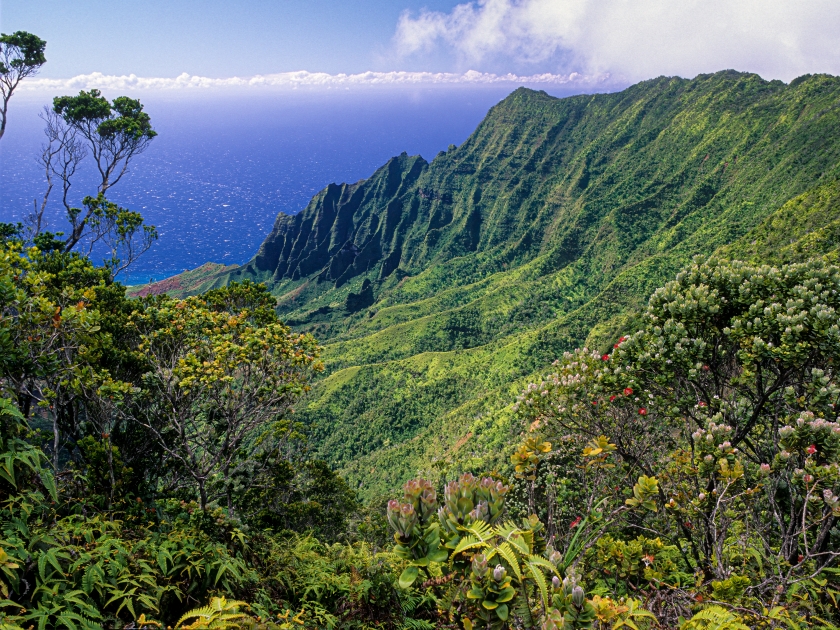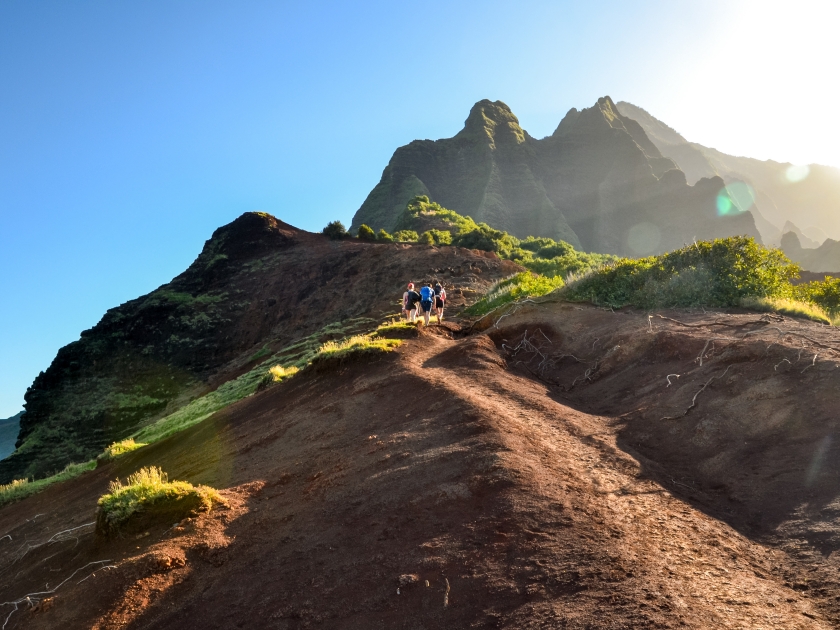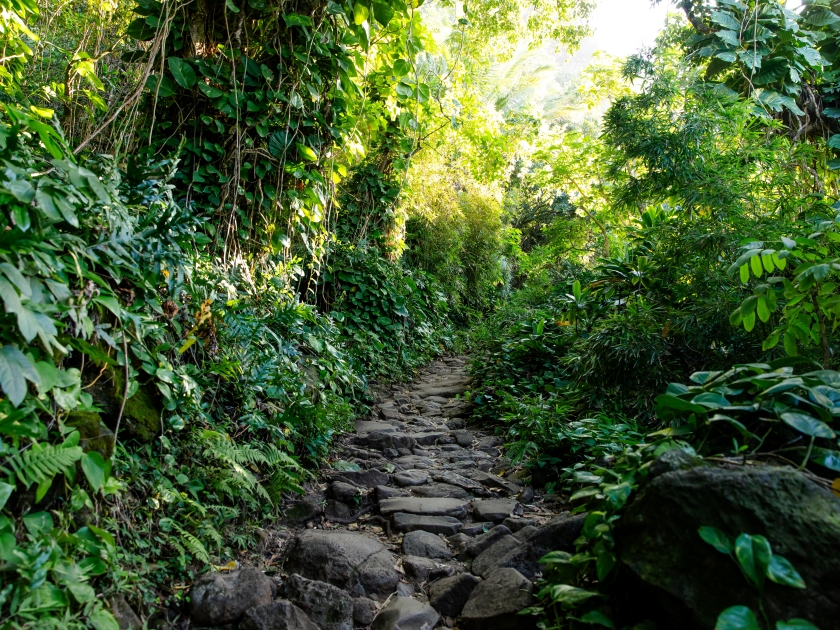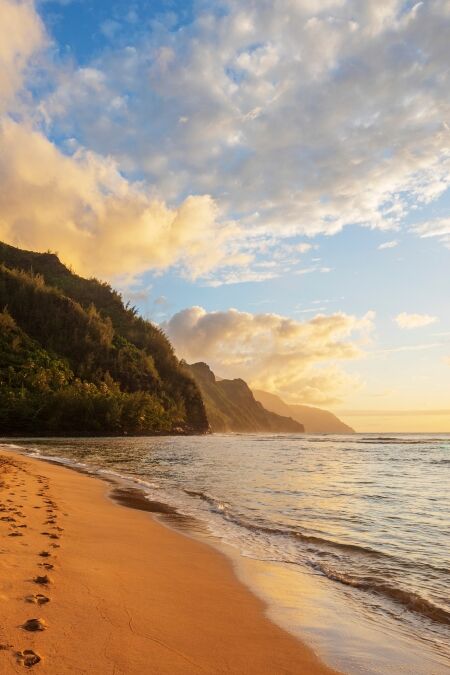Kalalau Valley, on the stunning northwest side of Kauai within the Nā Pali Coast State Park, is a secluded paradise celebrated for its rugged cliffs, lush landscapes, and deep cultural significance in Hawaiian history. Accessible only via the challenging Kalalau Trail or by kayak, it offers an unparalleled escape for hikers, adventurers, and nature enthusiasts seeking untouched beauty. This article provides a comprehensive guide to exploring Kalalau Valley.
Highlights
- Kalalau Valley offers some of the most stunning vistas in Kauai, especially from the Kalalau Lookout, which stands over 4,000 feet above sea level.
- The Kalalau Trail is an iconic 11-mile hike that leads to Kalalau Beach, providing adventurers with a challenging trek through diverse terrains and breathtaking coastal views.
- Kalalau Beach, accessible only via the Kalalau Trail or by kayak, offers a pristine escape where visitors can swim, sunbathe, and enjoy the serene surroundings.
- Camping here allows for a unique overnight experience under the stars.
- Capture stunning images during sunrise or sunset when the valley is bathed in warm hues.
- Enjoy birdwatching and exploring unique ecosystems that showcase Kauai’s natural beauty.
History

Early Inhabitants
Kalalau Valley was once home to a thriving Native Hawaiian community. While precise population figures are challenging to determine, estimates suggest the population of the Hawaiian Islands before European contact ranged from 100,000 to 1,000,000. Using the valley’s fertile land, they cultivated crops like taro and yams in terraced fields, a practice introduced by Polynesian navigators who first settled Kauai around 1,200 AD.
Arrival of Westerners
The arrival of Captain James Cook in Hawaii in 1778 marked the beginning of significant changes throughout the Hawaiian Islands, including the introduction of foreign diseases that decimated the Native Hawaiian population. Missionary efforts in the 19th century suppressed traditional customs, and many residents transitioned from subsistence farming to Western economic ventures.
Abandonment and Transition
By the early 20th century, Kalalau Valley was largely uninhabited, with its last permanent residents leaving around 1919. The land was repurposed for cattle grazing as it transitioned from a self-sustaining community to a protected natural space under ranch ownership. Today, the valley is part of Nā Pali Coast State Park, and habitation without permits is prohibited.
Countercultural Haven
In the 1960s and 1970s, Kalalau Valley became a retreat for countercultural “hippies” seeking freedom and simplicity. After the closure of Taylor Camp in Haena, many relocated to Kalalau, forming communes that attracted the attention of authorities. This era prompted regulations to manage camping and preserve the valley.
Modern Conservation
Now part of Nā Pali Coast State Park, Kalalau Valley is a haven for hikers and nature enthusiasts who access it via the challenging Kalalau Trail. While habitation without permits is prohibited, some adventurers attempt to live off the land, reflecting the valley’s legacy of self-reliance and natural beauty.
Getting There: The Kalalau Trail
Stretching 11 miles from Keʻe Beach to Kalalau Beach, the Kalalau Trail takes adventurers through five lush valleys, offering a challenging yet rewarding journey. Known for its steep climbs, narrow pathways, and breathtaking coastal vistas, this iconic trail is a true test of endurance. Most hikers take 7 to 10 hours to reach Kalalau Beach, with many opting to camp overnight to fully embrace the tranquility and natural beauty of this secluded paradise.
Exploring Kalalau Valley

Hiking
Beyond the iconic Kalalau Trail, the valley offers additional paths for those eager to venture deeper into its interior. These lesser-known trails weave through lush vegetation and remnants of ancient taro terraces, providing a closer look at the valley’s natural and cultural heritage.
Wildlife Watching
Kalalau Valley is a haven for nature enthusiasts, teeming with native birds like the pueo (Hawaiian owl) and unique plant species, including endangered flora such as Dubautia kalalauensis and Schiedea attenuata. Visitors should respect the natural habitat and avoid disturbing the flora and fauna.
Photography
With its towering cliffs, cascading waterfalls, and vibrant green landscapes set against the Pacific Ocean, Kalalau Valley is a photographer’s dream. Every angle provides a stunning view, making it one of the most picturesque spots in Hawaii for capturing nature’s beauty.
Camping
Camping in Kalalau Valley is a unique way to fully experience its remote beauty, with designated areas at Kalalau Beach and Hanakoa Valley. A valid camping permit is required and allows for up to five consecutive nights. At Kalalau Beach, camping is permitted on terraces near the beach or on the sand above the high tide line, offering breathtaking ocean views. Hanakoa Valley serves as a convenient midway stop, though campers are limited to non-consecutive nights in this area. Permits, priced at $35 per person per night (with discounts for residents), must be secured in advance due to high demand, especially during peak hiking seasons.
Tips for Visiting Kalalau Valley
- Secure Permits Early: Obtain hiking and camping permits well in advance, especially during peak seasons, as they often sell out.
- Prepare for the Trail: The Kalalau Trail is challenging; ensure you have sturdy footwear, sufficient water, and proper hiking gear.
- Pack Light but Smart: Bring essentials such as a lightweight tent, sleeping bag, first-aid kit, and water purification tools.
- Check Weather Conditions: Avoid visiting during the rainy season (November to March) to reduce risks of slippery trails and flash floods.
- Practice Leave No Trace: Respect nature by carrying out all trash and minimizing your environmental impact.
- Stay Hydrated: Carry enough water and refill from designated sources using purification methods.
- Respect Wildlife: Observe animals and plants from a distance to protect the valley’s ecosystem.
- Be Aware of Trail Hazards: Stay cautious around cliffs and narrow pathways, and avoid risky sections during inclement weather.
- Plan for Limited Facilities: Be prepared for rustic conditions with no cell service, minimal camping amenities, and limited freshwater access.
- Carry Safety Gear: Bring a map, compass, or GPS device, as the trail can be disorienting in some areas.
- Hike Responsibly: Stick to the trails to preserve the valley’s delicate environment and cultural sites.
Best Times to Visit

The dry season, spanning from April to October, is the best time to explore Kalalau Valley. During these months, the weather is generally more stable, with minimal rainfall and clearer skies, making it ideal for hiking and camping. However, given the valley’s tropical climate, it’s essential to monitor weather forecasts closely, as conditions can shift unexpectedly.
Frequently Asked Questions (FAQs)
The Kalalau Trail is an 11-mile hiking path on Kauai’s Nā Pali Coast, leading from Keʻe Beach to Kalalau Beach, known for its stunning views and challenging terrain.
Yes, a valid camping permit is required to hike beyond Hanakāpīʻai Valley; however, you can hike to Hanakāpīʻai Beach without a permit if you have a day-use reservation.
Permits can be secured through the Hawaii Department of Land and Natural Resources website, typically available 30 days in advance at midnight HST.
Overnight camping is allowed at Kalalau Beach and Hanakoa Campground, but both require permits; camping outside designated areas is prohibited.
Swimming is not recommended at Kalalau Beach due to strong currents and waves; caution should be exercised when entering the water.
Hikers should carry full backpacking gear, including sufficient water, food, first aid supplies, and appropriate clothing for varying weather conditions.
Trail to Tranquility
Kalalau Valley’s allure lies not only in its natural beauty but also in the adventure it demands and the serenity it offers. As you plan your trip, prepare thoughtfully and tread lightly to preserve this fragile paradise. Embrace the challenge, and Kalalau Valley will reward you with memories that echo the spirit of Hawaii’s wild and timeless charm.




